Enthronement of the Virgin Martyr Filumena in what will become known as her Shrine
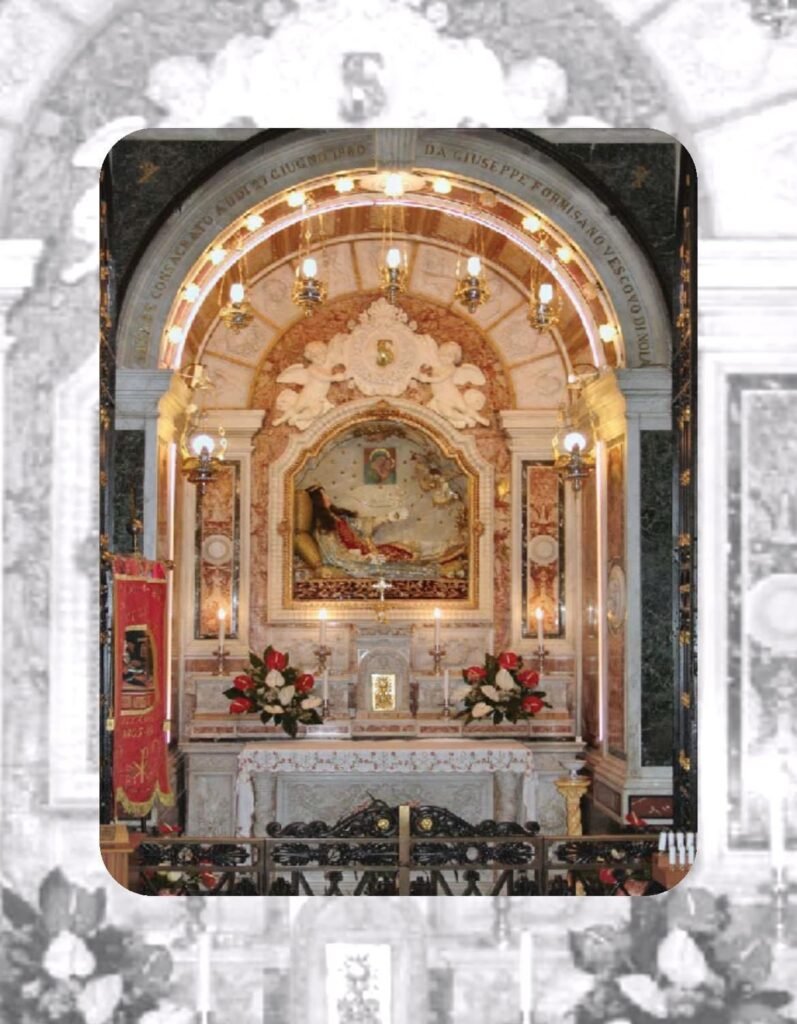
August 10, 1805 – Transfer of the Relics from Rome to the Sanctuary of St. Philomena, Mugnano del Cardinale, Av., Italy
The remains of Filumena departed from Rome on July 1, 1805, and arrived at Mugnano on August 10, 1805 where they have remained since the transferal.
In 1805, England was at war with France. At this time, France was linked with Ireland and Scotland had attempted to invade England with its aim on the Indian Empire. Napoleon, who had been the Commander-in-Chief of the French Army which invaded and conquered Italy, was now Emperor of France.
That summer, the Bishop-elect of Petenza went to Rome to be consecrated, and also to congratulate Pope Pius VII on his return from France, on behalf of the King of Naples, the Spanish Don Carlos. He took with him as his chaplain, a holy missionary priest, Don Francesco de Lucia Link Out, who was serving the parish of Mugnano north of Naples. Don Francesco, a cultured and pious priest, was born in Mugnano del Cardinale on September 19, 1772. He completed his studies in the Congregation of the Most Blessed Sacrament of Lucera. Ordained a priest on September 19, 1796, he opened a school of philosophy and literature in Naples. He quickly gained the esteem and affection of distinguished Neapolitan people in education circles. Amongst these was the Venerable Jesuit Servant of God, Guiseppe Maria Pignatelli.
Don Francesco De Lucia had a heavy heart as his parish was infested with impurities of revolutionary ideas, resentment against the authority of the Church, unbelief, and immorality. His secret hope was to get the Bishop to use his authority to get him the relics of a martyr – a Saint who would come back with him and help him convert his parish. He knew exactly what he wanted – a virgin martyr whose name was known.
The Guardian of the Custodia Generale, which Don Francesco soon got permission to visit, was evidently taken by this devout and humble priest, and said he would help him acquire what he desired, and told him to choose among the relics in the Custodia. In mid-May, Don Francesco was taken to the Treasure House of Relics, which was under the care of a worthy guardian, Monsignor Don Giacinto Ponzetti. There were those of thirteen martyrs, but only the names of three were known – one was a child, one an adult and then there was ‘Filumena.’ He had wanted a virgin martyr from the start, but what was more, when he stood before the case containing Filumena’s relics, he felt alive with spiritual joy, and it was as though She instantly took away the heaviness of his heart. This was undoubtedly the helper he wanted! The Guardian promised to arrange for this. Imagine his disappointment, then, when the official reply came that bodies of martyrs whose names were known were so few, that such as were found must be kept for special churches or dioceses.
His sadness doubled. Rome is not the best place in which to spend the summer – or at least it was not in those days, when the marshes of the Campagna had not been drained. As a result of the intense heat, and his considerable worry and disappointment, Don Francesco’s health began to decline. A friend offered him the relics of an unnamed martyr to comfort him, but he would not accept it. He was convinced that only Filumena could help him convert his parish. One night when he was burning with fever, he promised that if Filumena would grant him sleep, he would do everything possible to take her as his patron to Mugnano. Miraculously, his fever was gone and he fell asleep awakening in perfect health.
This confirmed to him that Filumena wanted to come with him to Mugnano just as much as he did. This time he went to the newly consecrated Bishop and asked him to use his influence. When the Bishop heard the story, he agreed that the Saint appeared to want to go to Mugnano and added his request to Don Francesco’s. The Guardian gladly acted on this permission to entrust the relics to Don Francesco and felt certain that Filumena would perform miracles in Mugnano.
Delighted, the good Bishop and Don Francesco took possession of the precious casket and proceeded to bring Filumena to Naples. With many prayers and every honor, the casket was placed in the front of the Episcopal carriage.
The cortege was due in the little town on Sunday, August 10, and on the vigil, bells were joyfully rung to announce the event. At dawn, a messenger was sent by Don Francesco to proclaim that the sacred body was coming. Soon an unusual excitement reigned, and crowds were seen proceeding from all directions to meet and welcome Her. The day was to be noted as a memorable one in the archives of Mugnano. More than forty priests in their richest vestments, the members of the various confraternities and representatives from the neighboring parishes went in procession displaying their banners. The road was strewn with olive branches and exquisite flowers. When the body came into sight, all the bells were heard “sprinkling air with holy sounds,” and heavenly music, sounds of bomb and gun fire, and groups of young men and young girls united in song welcomed Her in the most honourable way.
After entering the town, the cortege took fully two hours to reach the church of the Madonna del Grazie. Upon arrival of the sacred body, it was deposited under a triumphal dias near the Gospel side of the high altar, and Solemn High Mass was sung.
Don Francesco de Lucia had planned that this roman martyr was for a private chapel for his personal prayer however upon arrival there was no doubt this martyr would be staying in the main part of the church. This began the work or erecting an altar and getting the money to pay for this would be hard work. In deep prayer and faith, the altar was finally being installed when all present saw the altar separate and halved in two. Don Francesco de Lucia said we have no choice but to kneel and pray while this work continues, and he instructed the worker to carry on placing the altar. To the astonishment of all present it was perfectly fitted and miraculously joined together leaving only a hairline mark on it which can still be seen today (this altar was replaced 1875 and is now situated at the side).
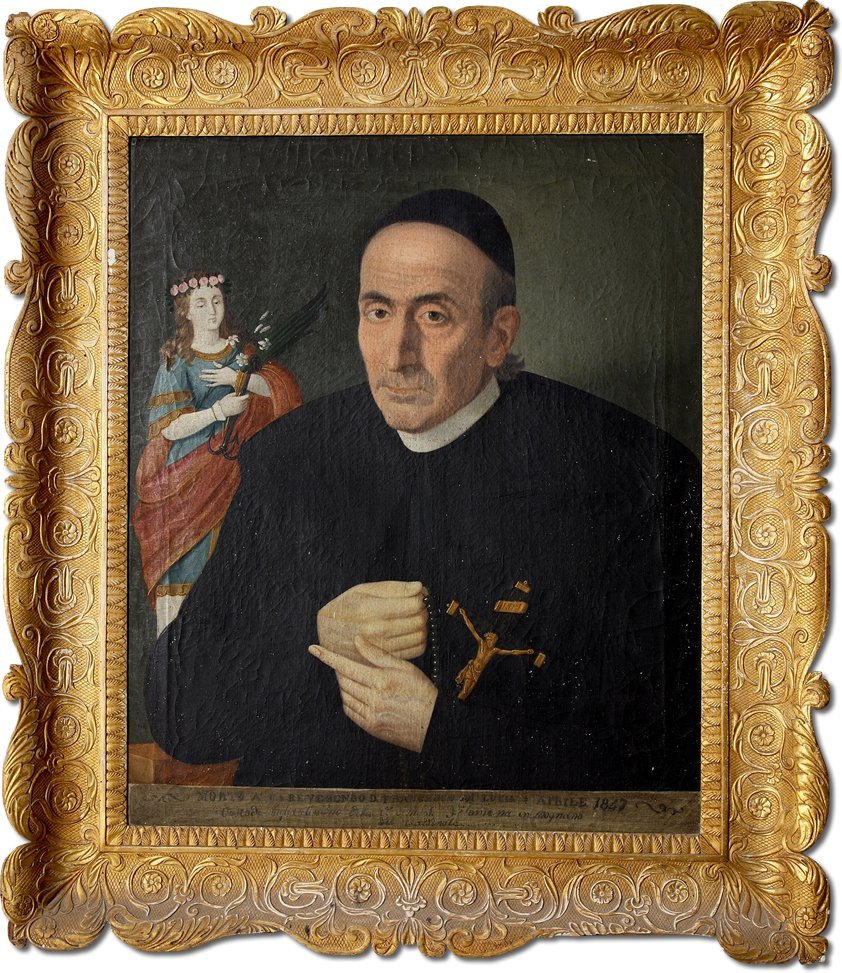
Don Francesco de Lucia, to give a solid and profound base to the devotion to the Saint, founded the Association of the Children of St. Philomena. He was the first rector of the sanctuary and most vigilant guardian of the holy remains of the Saint. He dedicated his priestly life for the glory of God and for souls. After 41 years of untiring apostolate in the propagation of devotion to Saint Filumena in all the Kingdom of the Two Sicily’s, acquiring the regard of cardinals and bishops, he rendered his great soul to God on April 9, 1847.
The presence of Saint Philomena is especially palpable at the Sacred Altar where her Relics are contained within the Paper Mache Statue and beside it, the vial of dried blood. As one enters the church and proceeds halfway up the main nave, this chapel is to the left. Facing it are the original slabs found at the tomb. For many years the museum contained the chair that Bl. Pauline Jaricot sat on when she miraculously recovered from a fatal illness ( now moved to a side altar) this is known as the “Great Miracle of Mugnano“. The Miraculous Statue of Saint Philomena can be found high in an alcove to the left of the main altar with the statue of Our Lady of Grace and it faces the Sacred Heart statue. The Sanctuary consists of the main Church, a Museum, Shop and the Pilgrims Centre. The pilgrim’s center has been partly restored and can now take a pilgrimage of approximately 50 devotees.
History of the Sanctuary of St. Philomena
- The building of the Sanctuary began in 1594 and finished in 1683 and opening to the public.
- In 1980 – 23rd November there was a minor earthquake in the region and the sanctuary was untouched.
- 1981 – 14th Feb (remember at this point that St Philomena was removed from the liturgical calendar in 1961, 14th Feb) There was a bigger earthquake in the town of Mugnano del Cardinale where houses fell down and the town was badly hit. The children of the town where in school that day. They where on their way to the Sanctuary on the road which is a hill leading up the sanctuary when the earthquake struck the whole area. The school was in ruins and destroyed but the children where just outside the Sanctuary and were saved (there is a painting depicting this in the museum in the Sanctuary there is a photo of this in the professional pictures with two huge painting – not well done due to the lack of space the photographer had to take them). Many house where destroyed in and around the town, but no one died.
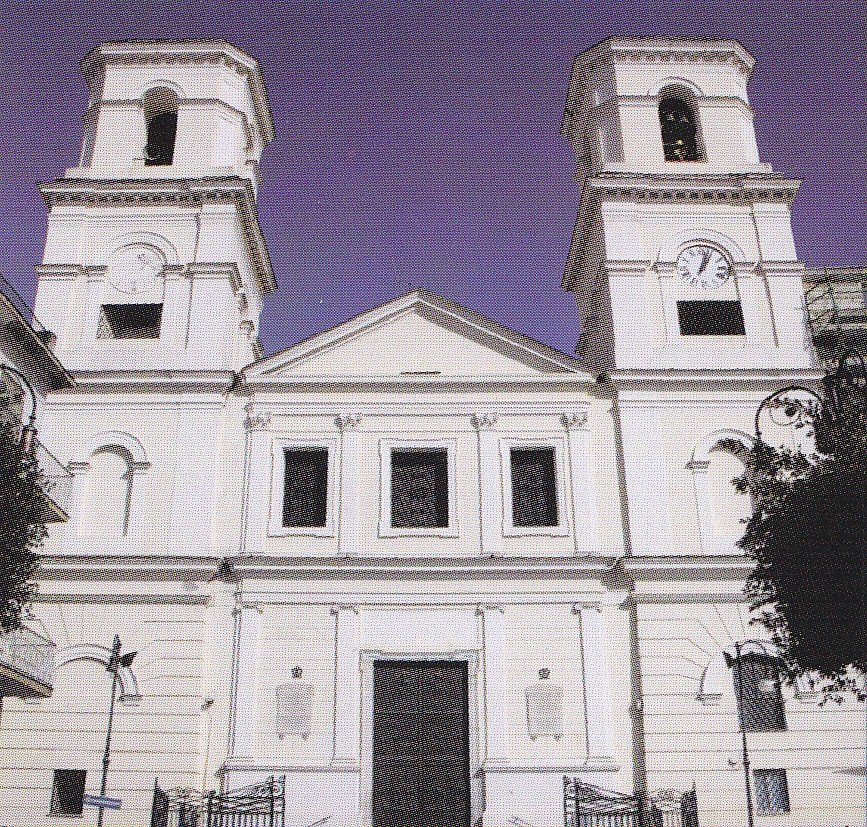
Why was the Sanctuary built?
In 1567, in the time of Counts and Barons who reigned the areas, the Cardinale d’Aragon was the owner of Mugnano and surrounding areas. He sold this area to Santa Casa dell’Annunziata of Naples – which was a moral association who helped poor people and they in turn were helped by the rich. This association put a high cost on funerals and the use of the local parish church “The Ascension”. The poor people of the town could not afford to have funerals in the church or for that matter go to church so they began to have private burials for their people in a near by town of Cimitile, this is also where many martyrs where buried and where the Sacred Relics of St Philomena became very heavy so much so that they had to be laid down for there was not enough man power to carry them, while on they way to Mugnano to be enthroned in the church.
At that time the “l’Universita” which is an old term for the town council of Mugnano decided to construct a church of the people.
It was built from money earned from a forest on a whole mountain. Trees were cut down and sold and this money was used to build the church. The Santa Casa dell’Annunziata of Naples where the owners of the area however the town council was the voice of the people. The Sanctuary was the ownership the town council and they where responsible for it. It came under the “dirito patronale” who was the mayor. He nominated a priest for the Rectory of this Church. The local Bishop had no problem with this as it was a time of many priests.
The Church was called Our Lady of Grace who was elected the Patroness of Mugnano. The statue according to the historian Fr. Fabio dell’Annunziata (Padre Fabio dell’Annunziata – Le Gorie del Monte Verginio – Napoli, 1804 page 180). The sculptor of the statue of Our Lady of Grace was a Naples artist Giacomo Colombo 1679-1718. This statue has never been restored or repainted, it remains to this day in full colour and perfect condition. Before the statue was in place in the church there was a picture. This picture was taken to a nearby little church and painted over to become Our Lady of Monte Virgine – this was discovered when it was being restored to its original condition.
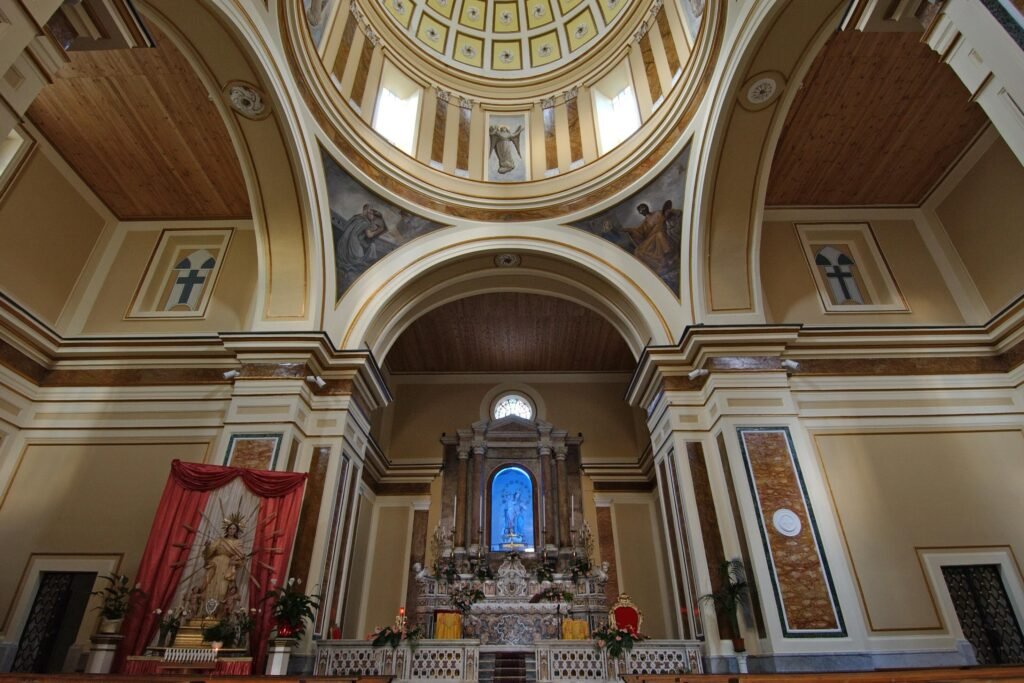
Taking a tour of the Altars of the Sanctuary, the centuries of prayer and miracles.
The church was built 1594-1683 in honor of Our Lady of Grace. Her statue is situated above the high altar and dates to around 1750, the face of Our Lady and the Baby Jesus has never been restored. The ceiling of the church depicts the story of Our Lady, which has been restored in 1717 and again in 1995. The Sanctuary of St Philomena, Virgin Martyr and Wonderworker, was following the translation of her sacred relics in 1805. From the very beginning the Sanctuary became a place of pilgrimage. Devotees of the Saint flocked to this shrine to pray before her relics. Wonders and miracles became the order of the day! Saints and Blessed, Kings and Queens, Princes and paupers came to invoke the great Wonderworker. St Philomena’s most illustrious pilgrim was Pope Blessed Pius IX, who celebrated the Holy Sacrifice of the Mass at her Altar on November 7, 1849. The Ven. Pauline Jaricot, founder of the Society for the Propagation of the Faith, came on pilgrimage in 1835 and was cured of a fatal illness while at the Shrine. A 30-year restoration program was begun by the late Rector, Msgr. Giovanni Braschi, the beautiful Sanctuary Church been sympathetically redecorated, a comfortable pilgrimage centre has also been created for the spiritual life of the Sanctuary. It is now able to provide accommodation for devotees who wish to spend some time at the feet of St Philomena.
The construction of the Sanctuary of Saint Philomena or the church of Santa Maria delle Grazie was begun in 1594 thanks to funds raised from cutting the woods of Vallicelle. Around 1763 the church was even more richly decorated and furnished, with very fine stucco, with a floor also made of coloured squares with a design, but much more solid and more beautiful than the first, with the current marble balustrade, which closes the presbytery, with the current richly carved pulpit, with the beautiful ceiling, painted by the famous Muzzillo, and another organ which was more expensive and much more harmonious than the first.
The church was built in the shape of a Latin cross with a nave, an elegant dome, Renaissance style and an altar adorned with precious and rare marbles.
On the eastern side there was a bell tower 50 meters high that on top had a dome with a bronze ball topped with a flag and a cross. On 30th May 1673 the tower was struck by lightning and collapsed damaging the church. It was rebuilt in a manner faithful with the support of the population. In the mid-eighteen century two bell towers were inserted. The facade is covered with stucco (plaster) of color yellow and flanked by two towers: one for the clock, the other for the bell. The architecture is neoclassical with Ionic and Corinthian capitals.
The church of Santa Maria delle Grazie in the early 1800s becomes the Sanctuary of Saint Philomena. The body of the Saint, found in Rome on 25th May 1802, was brought to Mugnano by the priest Don Francesco de Lucia on 10th August 1805. Don Francesco de Lucia was the first rector of the Sanctuary, who founded and extended the devotion of Saint Philomena in the kingdom of the Two Sicilies and across the ocean to the Americas.
Great personalities have visited the shrine by rich gifts: the Cardinal Ruffo-Cilla of Naples, Leone XII, Pope Gregory XVI, Pius IX who made a pilgrimage accompanied by King Ferdinand II on 7th November 1849, Pauline Jaricott (founder of the Pontifical Missionary Works) miracle by Saint Philomena in Mugnano on 10th August 1835, the Saint Cure of Ars, Maria Cristina of Savoy, wife of Ferdinand II of Bourbon, Leone XIII.
Among the devoted and promoters of the devotion of St. Philomena popes there were Leone XII and Leone XVI after the miracle of Pauline Jaricott, which took place before the altar of St. Philomena on 10th August 1835, made the official the devotion of the saint in all the Church; Leo XIII promulgator of the universal Archconfraternity of Saint Philomena, St. Pius X, a great devotee who enriched the Sanctuary of fine gifts. The nobility in memory of the sanctuary was constituted by the major principles (churches, glass window, statues) in Europe.
Altars to the Right of the Church as you enter
- Chapel of St. Anthony – the statue dates to around 1750. Annually his feast is celebrated in the town in June. The festa dates to before the body of St Philomena arrived at this church.
- Chapel of the Tomb of St Philomena – these are the original tiles from the tomb of St Philomena discovered in the catacombs of St. Pricilla in 1802. Donated to the Sanctuary by Pope Leo XII. The picture above this altar is of the martyrdom of St Philomena. It was painted in the Royal Palace of Casserta in 1859 by Gabriella Burboni.
- Chapel of St Rose of Lima and St. Catherine of Alexandria the picture dates to 1550 approx.
- Chapel of Blessed Pauline Jaricot, a modern depiction of her story along with the historical chair she sat on when miraculously cured which sitting at the Sacred Altar of the body of Saint Philomena, known as the “Great Miracle of Mugnano”, which Pope Gregory XVI was witness to.
- Entrance to the Sacristy – which was restored 2002 though the donated by the 1st group Battenti and the Paulo Corbisiero & Antonietta Braschi.
- Entrance to the Pilgrims House.
- Sacred Heart of Jesus Statue – from around 1896, this statue has never been restored.
Altars to the Left of the Church as you enter
- The tomb of Don Francesco de Lucia – the first Rector of the Sanctuary born in the town and first devotee of St. Philomena. His work was honored by the privilege of being buried within the Sanctuary. His tomb was restored in 2005, and the bronze bust placed above in his memory.
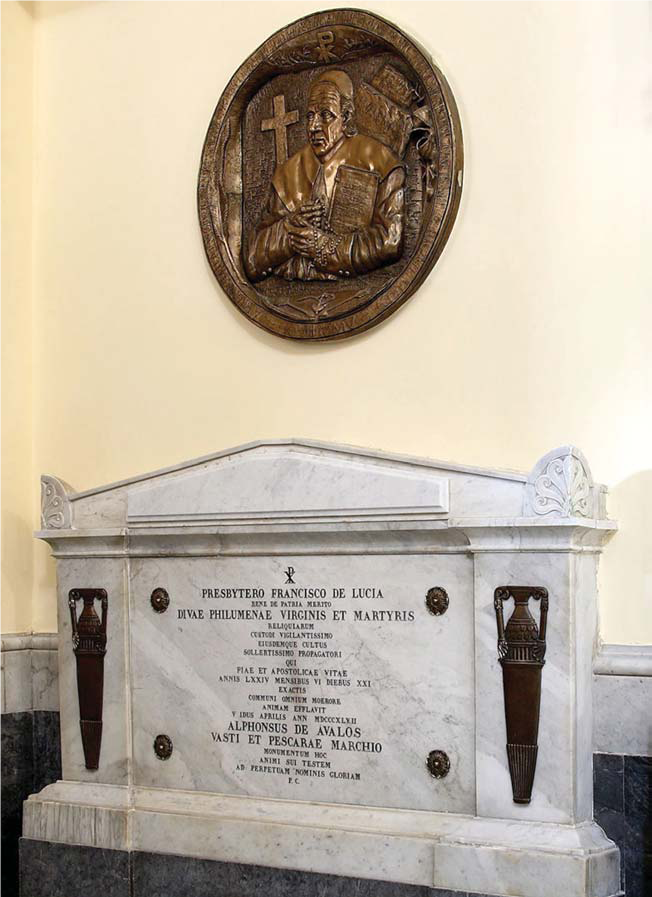
- Crucifix Chapel – the chapel of confession. This was created by the former Rector, Msg. Braschi as a spiritual place of reflection and reconciliation. The confessional booths are from 1974. The Crucifix dates back to the 1600’s. This was discovered by Msgr. Braschi in the Sanctuary and had been badly handled. Luigi Falco restored to its natural state this and had it analyzed and dated in Milan. The Altar is made up of three pieces of marble: 1600, 1700, and 1800. Found within the Sanctuary. Left in this chapel is a “Lapide” a piece of marble with historical information regarding the devotion. Stained glass window was donated by the Archconfraternity (center 3) in Scotland knows as The Family of St. Philomena, 18th April 2015. Outside of this chapel situated above the doors is a statue of St. Joseph from 1700’s which was restored in 2002. To the right of the entrance is St Blasé dating back to 1750 and was restored in 1986.
- St. Philomena Scared Altar – 10th August 1805. This is the new altar (not the original) which was donated 1877 by the Archconfraternity members of France headed by Mr Garrigou at the request of Abbe Louis Petit who founded the confraternity in France and was the first worldwide director of the universal archconfraternity of St. Philomena. The oil lamp was initiated at the time St Philomena was enshrined to have a perpetual light burning at her sacred remains. Within the Urn is the paper mache statue of St Philomena within this is the full body of St. Philomena. Looking toward this to the bottom left is the vial of dried blood situated within the cement and halved. Just in front of this altar is where Blessed Pauling Jaricot sat when she was miraculously healed.
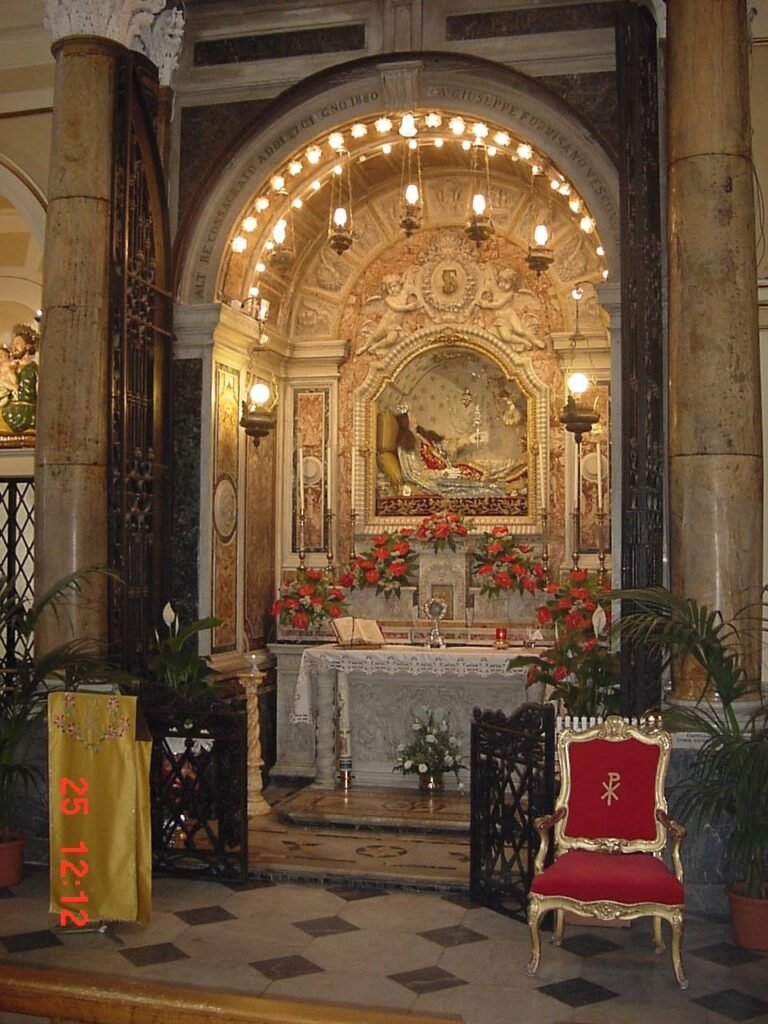
- Miraculous Altar – this is the original altar of St Philomena chapel. It was moved in 1875 for the construction of a new and more elaborate altar. This is known as the miraculous altar because as it was being put in place it cracked into two separate pieces. However the work carried on and as the sculptor put the altar in place the two pieces sealed together in front of the workmen who were gather in front. When in its original position, at this Altar many Cardinals and Bishops celebrated mass including Pope Pius IX.
- Statue of St. John Vianney & St. Philomena – Paper mache statue from a famous school of art in Lece, Southern Italy in 1890. The sanctuary ordered this work done to demonstrate the great love and devotion that St. John Vianney has for our Saint. Through him bore the devotion of the cord which was entrusted to the Archconfraternity and indulges granted for its use by members as the sign of membership. St. John Vianney attributed many miracles in his church to St Philomena. The cord is a sacramental of the Archconfraternity which is also a district attire as marking members.
- St. Ann with her daughter Mary as a child – donation in 2003 by the family Dr. Elvira Vasta and the statue dates back to 1896 approximately.
- Saints & Martyrs Reliquary – Dates back to 1700. An antique collection of relics of various saints and martyrs. The most famous is St John Vianney. A reliquary has been artistically constructed and created by the artist Gennaro Ippolito
- Miraculous Statue of St. Philomena – In 1806 Cardinal Louis Ruffo Scilla (1750-1832), Archbishop of Naples (1802-1832), donated a wooden statue of Saint Philomena to the Sanctuary containing in its chest cavity a reliquary which enclosed a small bone particle belonging to the Martyr, as reported by Ippolito.
This statue is brought every year in procession through the streets of Mugnano, on the second Sunday of August. On August 10, 1823, during the procession, the statue became heavier. The next day, the statue sweated fragrant “manna” for three consecutive days. Regarding this, there are two public records; one signed by the Vicar Foraneo and by 17 priests of the clergy of Mugnano, the other by the Mayor, the Chancellor, and from the Members of the Council. These records were deposited in the municipal archive and in Our Lady of Grace Church in Mugnano. In memory of this, a marble inscription was placed in the Church of Our Lady of Grace. The archway of this statue was restored in 2005 and donated by the Beniamino Scettino
- St. Pio of Pietrelcina – commissioned and donated to the Sanctuary by Sister Bertilla (1934 – 2011). Who dedicated 25 years of continuous service to the Sanctuary and the devotion of St. Philomena. Through her loyal service the Sanctuary became home to devotees worldwide, a pilgrims rest of the weary where they knew she would take care of them.
(please note the statues may be placed differently depending on various feast celebrations)
Dome
The church was built in the shape of a Latin cross with a nave, an elegant dome, Renaissance style and an altar adorned with precious and rare marbles. Depincted inside the dome are the 4 evangelists, Matthew, Mark, Luke and John
Doors
The bronze door of the Sanctuary of Saint Philomena was sculpted by William Savini and donated by the municipality of Mugnano del Cardinale. The portal consists of 6 panels in bas-relief depicting the history of the Sanctuary.
The first panel of the door on the left shows the construction of the Church of the Madonna delle Grazie. In the central panel depicts the translation of the sacred body of St. Philomena, while in the third panel is reproduced Cure of Ars that promotes the glories of Saint Philomena.
The first panel on the right shows Saint Philomena protecting the country of Mugnano del Cardinale. In the central panel depicts the miracle of Pauline Jaricot occurred on 08th august of 1835. In the last panel at the bottom there Saint Philomena with the royal family of Naples and the Popes wishing the hope of peace for the family of Saint Philomena.
The base of the portal shows the year of construction and the symbols of Saint Philomena and the symbol of the city of Mugnano Cardinal.
The portal was blessed by Cardinal Luigi Poggi in the jubilee of 2000.
Museum
Finished 1995 to represent the martyrdom of saint Philomena by the Rector. Statues from 1850’s existed in the sanctuary. Bronze sculptor of St Philomena – created in 2005 to commemorate the 200th anniversary of the translation of the sacred body.
The central hall of the shrine is surmounted by a wooden plank in Baroque style of the early 1600 (XVII century),the author is unknown. The lacunar is made of 9 panels including 3 central and 6 lateral. The three central panels represent the glory of Mary: the first panel depicts the dormitio, the central Mary’s Assumption into heaven, and the third the coronation. The six lateral panels represent the most important moments of Jesus’ and Mary’s life. In other rectangular panels are shown the theological virtues.
The dresser was restored in 1717 by De Pascalis.
Organ
Work carried out at the end of 1900’s centuary, on the occasion of the celebration of the first centenary of the transfer of the body of Saint Philomena. It is surmounted by 2 columns and is composed of about 2000 barrels. The sound box is inlaid in gold. The work was carried out by Neapolitan artists and the architect was Ippolito.

